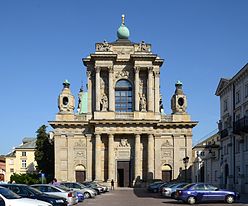- Carmelite Church, Warsaw
-
Carmelite Church 
Church of the Assumption of the Virgin Mary and of St. Joseph.General information Architectural style Baroque (façade Neoclassical, 1761-83) Town or city Warsaw Country Poland Construction started 1661 Completed 1681 Design and construction Client Michał Stefan Radziejowski Architect Jan Szymon Belotti, Efraim Szreger (façade) Church of the Assumption of the Virgin Mary and of St. Joseph (Polish: Kościół Wniebowzięcia NMP i św. Józefa Oblubieńca) commonly known as the Carmelite Church (Polish: Kościół Karmelitów) is a Roman Catholic church at Krakowskie Przedmieście 52/54 in Warsaw, Poland.
The Carmelite Church has Warsaw's most notable neoclassical-style façade, created in 1761-83. The church assumed its present appearance beginning in the 17th century and is best known for its twin belfries shaped like censers.
Contents
History
The present church is the second building to have arisen here, erected over the site of a wooden church originally constructed for the Discalced Carmelite order in 1643 and burned down by the Swedes and Brandenburg Germans in the 1650s.[1][2]
The new building was founded in 1661 by Polish Primate Michał Stefan Radziejowski, who also established Warsaw's Holy Cross Church. It was built in 1692-1701 to the plan of Józef Szymon Bellotti.
The church's basic structure had been largely completed by the end of the 17th century, but the present façade was not begun till 1761. It was erected by Karol Stanisław Radziwiłł, who commissioned the Hungarian architect Efraim Szreger[3] to draw up a plan for a comprehensive new façade. This impressive façade was built in a style typical for the reign of King Stanisław August Poniatowski, with dominant columns supporting the cornice.
The distinguished 18th-century artist Szymon Czechowicz embellished the church with his paintings. Another leading Polish painter, Franciszek Smuglewicz, created altar paintings. The interior is opulent, with magnificent rococo main altar, gilding and stucco ceiling decorations.
The Carmelite Church was the site of Fryderyk Chopin's first employment. He was invited to give a recital on the church's organ.[1]
In 1864, after the January Uprising was brutally crushed by Russians, the monastery was liquidated by the tsarist regime as a stronghold of Polish patriotism. The buildings have been since adapted for the Warsaw Archdiocesan Seminary and the former Carmelite church serves as the seminary church.
During World War II the church was saved from deliberate destruction by the retreating German forces and was only slightly damaged.[1] It served as a procathedral until the reconstruction of St. John's Cathedral.
References
- ^ a b c (Polish) "Kościół Karmelitów". webpark.pl. http://www.matematikus.webpark.pl/index_pliki/Page1375.htm. Retrieved 2008-02-09.
- ^ (Polish) "Kościół Seminaryjny". dziedzictwo.ekai.pl. http://www.dziedzictwo.ekai.pl/@@warszawa_kosciol_seminaryjny. Retrieved 2008-02-09.
- ^ Efraim Szreger
-
- General:
- (Polish) Stefan Kieniewicz, ed (1984). Warszawa w latach 1526-1795. Warsaw. ISBN 83-01-03323-1.
See also
- Presidential Palace
- St. Anne's Church
- St. Florian's Cathedral
External links
- Carmelite Church
- (Polish) www.warszawa1939.pl
- (Polish) www.dziedzictwo.ekai.pl
Coordinates: 52°14′36″N 21°00′56″E / 52.24333°N 21.01556°E
Categories:- Religious buildings completed in 1701
- 1783 architecture
- Carmelite churches
- Roman Catholic churches in Warsaw
- Neoclassical architecture in Warsaw
Wikimedia Foundation. 2010.

